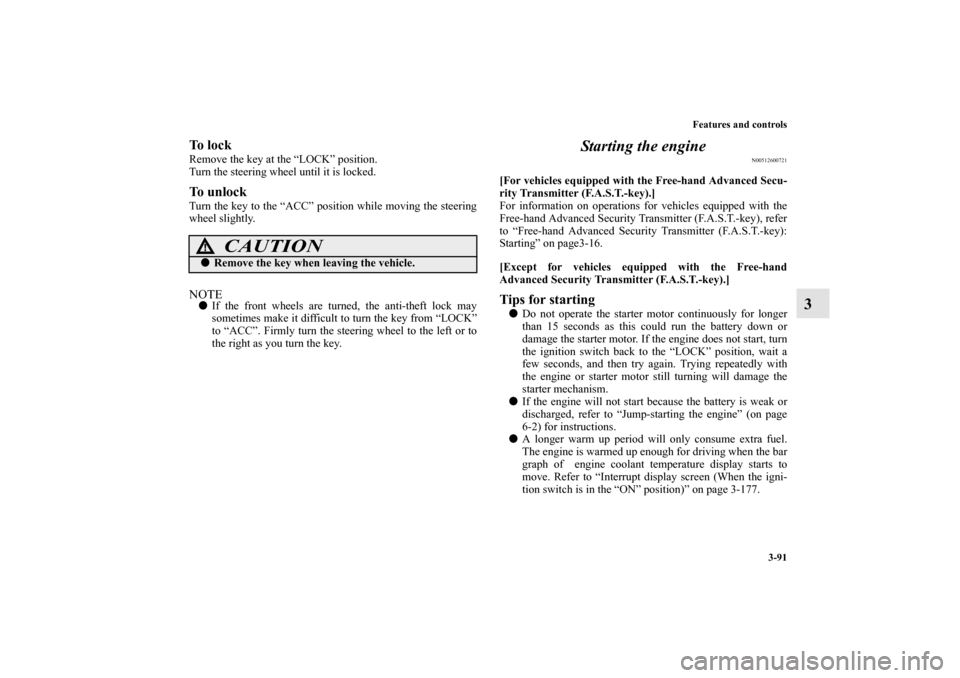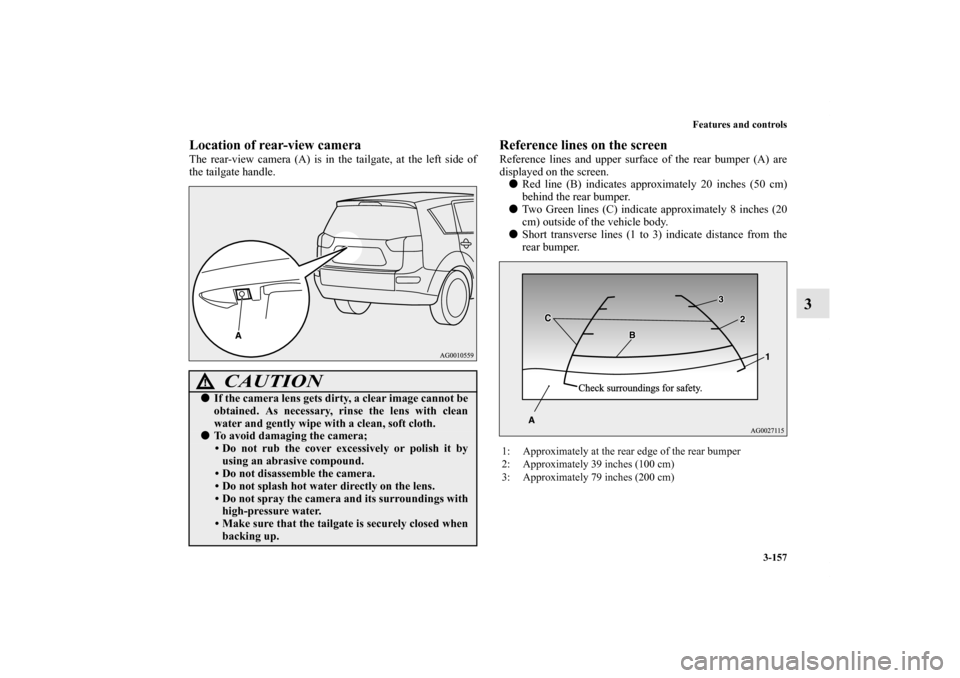Page 205 of 714
![MITSUBISHI OUTLANDER 2012 3.G Owners Manual 3-90 Features and controls
3Steering wheel lock
N00512500166
[For vehicles equipped with the Free-hand Advanced Secu-
rity Transmitter (F.A.S.T.-key).]
For information on operations for vehicles equip MITSUBISHI OUTLANDER 2012 3.G Owners Manual 3-90 Features and controls
3Steering wheel lock
N00512500166
[For vehicles equipped with the Free-hand Advanced Secu-
rity Transmitter (F.A.S.T.-key).]
For information on operations for vehicles equip](/manual-img/19/7525/w960_7525-204.png)
3-90 Features and controls
3Steering wheel lock
N00512500166
[For vehicles equipped with the Free-hand Advanced Secu-
rity Transmitter (F.A.S.T.-key).]
For information on operations for vehicles equipped with the
Free-hand Advanced Security Transmitter (F.A.S.T.-key), refer
to “Free-hand Advanced Security Transmitter (F.A.S.T.-key):
Steering wheel lock” on page3-32
[Except for vehicles equipped with the Free-hand
Advanced Security Transmitter (F.A.S.T.-key).]
CAUTION
!�If the engine is stopped while driving, the power
brake booster will stop functioning and greater
effort for braking will be required. Also, the power
steering system will not function and it will require
greater effort to manually steer the vehicle.�Do not leave the key in the “ON” position for a long
time when the engine is not running. This will cause
the battery to run down.�Do not turn the key to the “START” position when
the engine is running. It will damage the starter
motor.
BK0138000US.book 90 ページ 2011年4月13日 水曜日 午前11時17分
Page 206 of 714

Features and controls
3-91
3
To l o c kRemove the key at the “LOCK” position.
Turn the steering wheel until it is locked.To u n l o c kTurn the key to the “ACC” position while moving the steering
wheel slightly.NOTE�If the front wheels are turned, the anti-theft lock may
sometimes make it difficult to turn the key from “LOCK”
to “ACC”. Firmly turn the steering wheel to the left or to
the right as you turn the key.
Starting the engine
N00512600721
[For vehicles equipped with the Free-hand Advanced Secu-
rity Transmitter (F.A.S.T.-key).]
For information on operations for vehicles equipped with the
Free-hand Advanced Security Transmitter (F.A.S.T.-key), refer
to “Free-hand Advanced Security Transmitter (F.A.S.T.-key):
Starting” on page3-16.
[Except for vehicles equipped with the Free-hand
Advanced Security Transmitter (F.A.S.T.-key).]Tips for starting�Do not operate the starter motor continuously for longer
than 15 seconds as this could run the battery down or
damage the starter motor. If the engine does not start, turn
the ignition switch back to the “LOCK” position, wait a
few seconds, and then try again. Trying repeatedly with
the engine or starter motor still turning will damage the
starter mechanism.
�If the engine will not start because the battery is weak or
discharged, refer to “Jump-starting the engine” (on page
6-2) for instructions.
�A longer warm up period will only consume extra fuel.
The engine is warmed up enough for driving when the bar
graph of engine coolant temperature display starts to
move. Refer to “Interrupt display screen (When the igni-
tion switch is in the “ON” position)” on page 3-177.
CAUTION
!�Remove the key when leaving the vehicle.
BK0138000US.book 91 ページ 2011年4月13日 水曜日 午前11時17分
Page 212 of 714
Features and controls
3-97
3
4. Depress the brake pedal with the right foot.
5. Turn the ignition switch to the “ACC” position.NOTE�For vehicles with the Free-hand Advanced Security
Transmitter (F.A.S.T.-key), turn the ignition switch to the
“ACC” position with the emergency key if the vehicle
battery is flat.
6. Insert a screwdriver in the shift-lock release hole (B).
Shift the selector lever to the “N” (NEUTRAL) position
while pressing the screwdriver down.
Selector lever position display
N00513900415
When the ignition switch is turned to the “ON” position, the
selector lever position is shown on the multi-information dis-
play. Type 1 Type 2
BK0138000US.book 97 ページ 2011年4月13日 水曜日 午前11時17分
Page 222 of 714
Features and controls
3-107
3
4. Depress the brake pedal with the right foot.
5. Turn the ignition switch to the “ACC” position.NOTE�For vehicles with the Free-hand Advanced Security
Transmitter (F.A.S.T.-key), turn the ignition switch to the
“ACC” position with the emergency key if the vehicle
battery is flat.
6. Insert a screwdriver in the shift-lock release hole (B).
Shift the selector lever to the “N” (NEUTRAL) position
while pressing the screwdriver down.
Selector lever position display
N00560400049
When the ignition switch is turned to the “ON” position, the
selector lever position is shown on the multi-information dis-
play.
Ty p e 2 Ty p e 1
BK0138000US.book 107 ページ 2011年4月13日 水曜日 午前11時17分
Page 243 of 714

3-128 Features and controls
3
Jacking up a 4-wheel drive vehicle
Service brake
N00517500275
Brake pedalOveruse of the brake can cause weakening, resulting in poor
brake response and premature wear of the brake pads.
When driving down a long or steep hill, use engine braking by
downshifting.
�Even in “2WD” or “TARMAC” mode, the vehicle
cannot be towed with the front or the rear wheels on
the ground.
WA R N I N G
!�Do not crank the engine while jacking up the vehi-
cle.
The tire on the ground may turn and the vehicle
may roll off the jack.
CAUTION
!
WA R N I N G
!�Do not leave any objects near the brake pedal or let
a floor mat slide under it; doing so could prevent the
full pedal stroke that would be necessary in an emer-
gency. Make sure that the pedal can be operated
freely at all times. Make sure the floor mat is
securely held in place.
CAUTION
!�It is important not to drive the vehicle with your foot
resting on the brake pedal when braking is not
required. This practice can result in very high brake
temperatures, premature lining wear, and possible
damage to the brakes.
BK0138000US.book 128 ページ 2011年4月13日 水曜日 午前11時17分
Page 272 of 714

Features and controls
3-157
3
Location of rear-view cameraThe rear-view camera (A) is in the tailgate, at the left side of
the tailgate handle.
Reference lines on the screenReference lines and upper surface of the rear bumper (A) are
displayed on the screen.
�Red line (B) indicates approximately 20 inches (50 cm)
behind the rear bumper.
�Two Green lines (C) indicate approximately 8 inches (20
cm) outside of the vehicle body.
�Short transverse lines (1 to 3) indicate distance from the
rear bumper.
CAUTION
!�If the camera lens gets dirty, a clear image cannot be
obtained. As necessary, rinse the lens with clean
water and gently wipe with a clean, soft cloth.�To avoid damaging the camera;
• Do not rub the cover excessively or polish it by
using an abrasive compound.
• Do not disassemble the camera.
• Do not splash hot water directly on the lens.
• Do not spray the camera and its surroundings with
high-pressure water.
• Make sure that the tailgate is securely closed when
backing up.
1: Approximately at the rear edge of the rear bumper
2: Approximately 39 inches (100 cm)
3: Approximately 79 inches (200 cm)
BK0138000US.book 157 ページ 2011年4月13日 水曜日 午前11時17分
Page 316 of 714
Features and controls
3-201
3
�There is a fault in the F. A. S. T. -key. Refer to “Free-hand Advanced Security
Transmitter (F.A.S.T.-key)” on page 3-16.
Screen type 1
Screen type 2
Cause
Do this (Reference)
BK0138000US.book 201 ページ 2011年4月13日 水曜日 午前11時17分
Page 317 of 714
3-202 Features and controls
3
Warning display list (With ignition switch in the “ON” position)
N00558100267
Screen type 1
Screen type 2
Cause
Do this (Reference)
�There is a fault in the F.A.S.T.-key. Refer to “Free-hand Advanced Security
Transmitter (F.A.S.T.-key)” on page 3-16.
BK0138000US.book 202 ページ 2011年4月13日 水曜日 午前11時17分